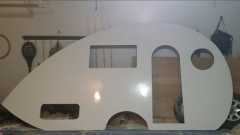It was a pretty chill weekend around the shop... difficult to keep the temps up above 50 degrees and not a lot going on. But I did manage to accomplish a few things...
As I continue to read and study about Filon, Luan and the different glues that bind them all together... The theme that continues to prevail is the instance of failure where the bonding agents, i.e. contact cement, epoxy, TB3 or whatever... is rarely at fault. It is most always an issue of the moisture getting in somewhere, (under trim, mouldings, screw holes, window/door seals, etc.) and then penetrating the edge of the Luan/Plywood. Over time the glue that bonds the layers of the Luan/Plywood together starts to deteriorate, break down, rot and the layers of wood (ply) rot right along with it. As I've said before, it's the layers of the Luan/Plywood separating from "itself." Not the bonded material separating from "it." This is how delamination occurs. So I'm thinking that regardless of how much epoxy is used to seal everything up, or together or whatever... It's the vulnerable edges that ultimately cause the issues. I've been told it's over kill, unnecessary, or "the RV manufactures don't even do that!" But I have now spent a considerable amount of time carefully going over the walls making sure that every tiny bit of wood is laminated under a nice layer of epoxy. I understand that the manufacturers don't do this added step... and that's fine. The difference between myself and them, or at least one of the differences, is they need to continue to build and sell caravans. I don't. Mine just needs to last for all eternity, forever and ever, Amen. Joking. Well sort of. I've discovered that most caravans do well up to the point of the expiration of warranty... just like most anything produced today... But I would like to build something that can be passed along for future generations of enjoyment. So... I'll add a couple pictures of the process. Which is very simple, yet effective and I believe will make the difference in the longevity of the product. Call it overkill. I call it insurance. At the very least, when and if something fails whether it be an edge moulding, a seal, butyl tape, caulking, etc., by the time the failure is discovered, it can be fixed without having to repair a bunch of rot as well... Or maybe, I'm just insane.















 that is a nice milestone and very good workmanship. Did you need to add solvent to West System epoxy to roll it on with foam roller like that?
that is a nice milestone and very good workmanship. Did you need to add solvent to West System epoxy to roll it on with foam roller like that?
